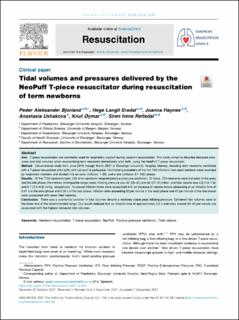| dc.contributor.author | Bjorland, Peder Aleksander | |
| dc.contributor.author | Ersdal, Hege Langli | |
| dc.contributor.author | Haynes, Joanna Clare | |
| dc.contributor.author | Ushakova, Anastasia | |
| dc.contributor.author | Øymar, Knut Asbjørn Alexander | |
| dc.contributor.author | Rettedal, Siren | |
| dc.date.accessioned | 2022-02-17T08:14:44Z | |
| dc.date.available | 2022-02-17T08:14:44Z | |
| dc.date.created | 2022-02-10T15:32:11Z | |
| dc.date.issued | 2022 | |
| dc.identifier.issn | 0300-9572 | |
| dc.identifier.uri | https://hdl.handle.net/11250/2979532 | |
| dc.description.abstract | Aim: T-piece resuscitators are commonly used for respiratory support during newborn resuscitation. This study aimed to describe delivered pressures and tidal volumes when resuscitating term newborns immediately after birth, using the NeoPuff T-piece resuscitator.
Method: Observational study from June 2019 through March 2021 at Stavanger University Hospital, Norway, including term newborns ventilated with a T-piece resuscitator after birth, with consent to participate. Ventilation parameters of the first 100 inflations from each newborn were recorded by respiration monitors and divided into an early (inflation 1–20) and a late (inflation 21–100) phase.
Results: Of the 7730 newborns born, 232 term newborns received positive pressure ventilation. Of these, 129 newborns were included. In the early and the late phase, the median (interquartile range) peak inflating pressure was 30 (28–31) and 30 (27–31) mbar, and tidal volume was 4.5 (1.6–7.8) and 5.7 (2.2–9.8) ml/kg, respectively. Increased inflation times were associated with an increase in volume before plateauing at an inflation time of 0.41 s in the early phase and 0.50 s in the late phase. Inflation rates exceeding 32 per minute in the early phase and 41 per minute in the late phase were associated with lower tidal volumes.
Conclusion: There was a substantial variation in tidal volumes despite a relatively stable peak inflating pressure. Delivered tidal volumes were at the lower end of the recommended range. Our results indicate that an inflation time of approximately 0.5 s and rates around 30–40 per minute are associated with the highest delivered tidal volumes. | en_US |
| dc.language.iso | eng | en_US |
| dc.publisher | Elsevier | en_US |
| dc.rights | Attribution-NonCommercial-NoDerivatives 4.0 Internasjonal | * |
| dc.rights.uri | http://creativecommons.org/licenses/by-nc-nd/4.0/deed.no | * |
| dc.title | Tidal volumes and pressures delivered by the NeoPuff T-piece resuscitator during resuscitation of term newborns | en_US |
| dc.type | Journal article | en_US |
| dc.type | Peer reviewed | en_US |
| dc.description.version | publishedVersion | en_US |
| dc.rights.holder | Copyright 2021 The Author(s) | en_US |
| cristin.ispublished | true | |
| cristin.fulltext | original | |
| cristin.qualitycode | 2 | |
| dc.identifier.doi | 10.1016/j.resuscitation.2021.12.006 | |
| dc.identifier.cristin | 2000125 | |
| dc.source.journal | Resuscitation | en_US |
| dc.source.pagenumber | 222-229 | en_US |
| dc.identifier.citation | Resuscitation. 2022, 170, 222-229. | en_US |
| dc.source.volume | 170 | en_US |

